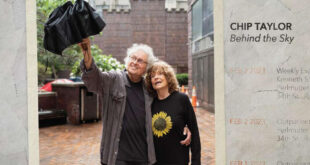Winnie-the-Pooh
Travis Dandro gives us a new look at A.A. Milne’s Winnie-the-Pooh as a graphic novel published by Drawn and Quarterly. With the original Winnie-the-Pooh hitting public domain in the United States in 2022, there has been a cavalcade of new interpretations, including comic strip guest appearances and horror movies. Dandro creates something a long time coming with a graphic novel adaptation that remains faithful to the original work that so many readers hold dear.

The text of Dandro’s Winnie-the-Pooh graphic novel comes directly from the source. A century after it first appeared as collections of bedtime stories Milne spun for his son Christopher, the antics of Pooh Bear and his companions in the Hundred Acre Wood continue to delight. Readers can follow Pooh’s first adventure as he schemes to steal honey from a beehive by rolling in black mud and flying on a balloon pretending to be a rain cloud. From there Pooh finds a tail just as Eeyore the donkey loses one, journeys alongside Christopher Robin to discover the literal North Pole, and rescues Piglet from his house surrounded by water when it rains for “days and days and days.” As timeless tales, the stories are just as much fun today as they were when they were new.
Just as the text is drawn from the original publication, Dandro’s art in Winnie-the-Pooh harkens back to the work of Ernest H. Shepard in 1926, itself based on the actual stuffed animals today preserved in the New York Public Library. Pooh looks much as he did in 1926 with his rounded body, while Piglet has a simpler snout along with his trademark torso stripes.
Dandro does not simply copy Shephard’s art, instead applying his own touch, with more rounded edges, especially on wise old Owl who is here much less austere. Rabbit is the most redeveloped, with much longer ears, prominent cheeks, and a snappy plaid vest that would certainly impress all of his many friends and relations.
The characters seem almost animated through Dandro’s effective use of panels, some with firm borders to create a moment of time and others practically flowing into one another in action. Simply flipping through the pages shows Dandro’s skill in bringing the time-tested stories to life.
For its art and storytelling alone, Dandro’s Winnie-the-Pooh is a must-read for graphic novel fans and children’s literature enthusiasts alike. Since Winnie-the-Pooh and his world has become such a part of the canon and world culture alike, looking back on the original adds yet more flavor to the book. Readers can see where so many cultural phenomena have come from, such as the Woozle Effect. At first, it is a charming story of Pooh and Piglet hunting a Woozle from its tracks in the snow. They pursue it only to be shocked when more tracks of more creatures join the first.
This is terrifying for Piglet and fascinating for Pooh as a growing mystery until Christopher Robin points out that the intrepid hunters are, in fact, following their own tracks in an enormous circle. Just as Pooh and Piglet are mistaken, so are academics and the media in the wider phenomenon of articles following their own citations in a circle to create something imaginary rather than finding a more accurate outside perspective. That is just one of many examples of how Winnie-the-Pooh proves to be an everlasting silly old bear to us all.
 Blogcritics The critical lens on today's culture & entertainment
Blogcritics The critical lens on today's culture & entertainment




